Qfind.net Redirect
![]() Written by Tomas Meskauskas on (updated)
Written by Tomas Meskauskas on (updated)
What is Qfind.net?
The Qfind.net website is promoted using malicious software. It is a browser redirect capable of harming your computer's security and invading your privacy. When infected with this redirect virus, your Internet browser settings will be modified; each time you open your Internet browser you will be redirected to sites such as qfind.net, the-lucky-winner.com, etc.
The qfind.net website appears as a parked domain full of advertisements. Clicking on the links presented in this website could lead to installation of additional malware or unwanted browser add-ons.
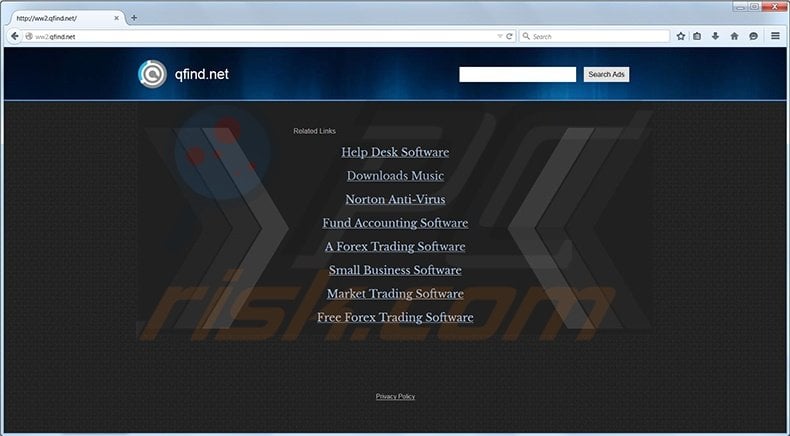
Furthermore, qfind.net redirects to other websites, for example: the-lucky-winner.com. This particular website displays deceptive ads stating that you have won something, and then requests completion of an online survey in order to claim your prize. These websites may also subscribe you to some expensive mobile services.
Computer users should avoid such websites, and if redirected to one, leave immediately. If your Internet browsers redirect you to qfind.net, this is a clear indication that your PC is infected with malware. Do not use this website as your homepage and remove this redirect as soon as possible, since leaving it on your PC may lead to additional malware infections.
As mentioned above, redirects to qfind.net indicate that your computer is infected with malware. Run a scan with legitimate antivirus and antispyware programs to resolve any possible security issues. Use the removal guide provided to eliminate redirects to this website.
Instant automatic malware removal:
Manual threat removal might be a lengthy and complicated process that requires advanced IT skills. Combo Cleaner is a professional automatic malware removal tool that is recommended to get rid of malware. Download it by clicking the button below:
▼ DOWNLOAD Combo Cleaner
By downloading any software listed on this website you agree to our Privacy Policy and Terms of Use. To use full-featured product, you have to purchase a license for Combo Cleaner. 7 days free trial available. Combo Cleaner is owned and operated by Rcs Lt, the parent company of PCRisk.com read more.
Quick menu:
- What is Qfind.net?
- STEP 1. Uninstall Qfind.net application using Control Panel.
- STEP 2. Remove Qfind.net redirect from Internet Explorer.
- STEP 3. Remove Qfind.net browser hijacker from Google Chrome.
- STEP 4. Remove Qfind.net homepage and default search engine from Mozilla Firefox.
- STEP 5. Remove Qfind.net redirect from Safari.
- STEP 6. Remove rogue plug-ins from Microsoft Edge.
Qfind.net redirect removal:
Windows 11 users:

Right-click on the Start icon, select Apps and Features. In the opened window search for the application you want to uninstall, after locating it, click on the three vertical dots and select Uninstall.
Windows 10 users:

Right-click in the lower left corner of the screen, in the Quick Access Menu select Control Panel. In the opened window choose Programs and Features.
Windows 7 users:

Click Start (Windows Logo at the bottom left corner of your desktop), choose Control Panel. Locate Programs and click Uninstall a program.
macOS (OSX) users:

Click Finder, in the opened screen select Applications. Drag the app from the Applications folder to the Trash (located in your Dock), then right click the Trash icon and select Empty Trash.
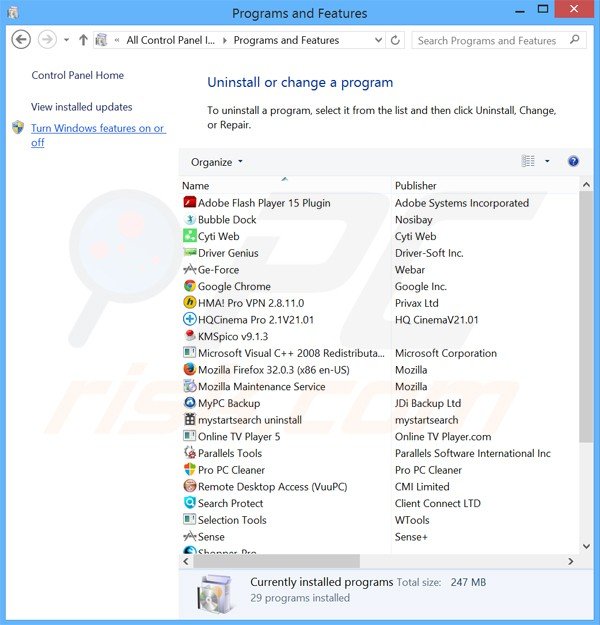
In the uninstall programs window: look for “Qfind.net”, select this entry and click "Uninstall" or "Remove".
Video showing how to remove potentially unwanted browser add-ons:
Step1: To remove qfind.net redirect, scan your computer with legitimate antispyware programs. Recommended malware removal software.
Step 2: Browser redirects can be a consequence of a modified system Hosts file. This is used to resolve canonical names of websites to IP addresses. When it is changed, computer users may be redirected to malicious websites, whilst still observing valid URLs in the address bar. To fix this, please download the Microsoft FixIt tool that restores your Hosts file to the Windows default. Run this tool when downloaded and follow the on-screen instructions. Download link below:
 Remove malicious add-ons from Internet Explorer:
Remove malicious add-ons from Internet Explorer:
Check for qfind.net related extensions: Click on the "gear" icon ![]() (at the top right corner of Internet Explorer) select "Manage Add-ons". Look for qfind.net related entries and disable them.
(at the top right corner of Internet Explorer) select "Manage Add-ons". Look for qfind.net related entries and disable them.
To change your homepage from qfind.net to your preferred domain: Click on the "gear" icon ![]() (at the top right corner of Internet Explorer) select "Internet Options", in the opened window, remove qfind.net and enter your preferred domain, which will open each time you launch Internet Explorer.
(at the top right corner of Internet Explorer) select "Internet Options", in the opened window, remove qfind.net and enter your preferred domain, which will open each time you launch Internet Explorer.
Optional method:
If you continue to have problems with removal of the qfind virus, reset your Internet Explorer settings to default.
Windows XP users: Click Start, click Run, in the opened window type inetcpl.cpl In the opened window click the Advanced tab, then click Reset.

Windows Vista and Windows 7 users: Click the Windows logo, in the start search box type inetcpl.cpl and click enter. In the opened window click the Advanced tab, then click Reset.

Windows 8 users: Open Internet Explorer and click the gear icon. Select Internet Options.

In the opened window, select the Advanced tab.

Click the Reset button.

Confirm that you wish to reset Internet Explorer settings to default by clicking the Reset button.

 Remove malicious extensions from Google Chrome:
Remove malicious extensions from Google Chrome:
Click the Chrome menu icon ![]() (at the top right corner of Google Chrome) select "Tools" and click on "Extensions". Locate entries related to qfind.net, select them and click on the trash can icon.
(at the top right corner of Google Chrome) select "Tools" and click on "Extensions". Locate entries related to qfind.net, select them and click on the trash can icon.
To change your homepage from qfind.net to your preferred domain - click the Chrome menu icon ![]() (at the top right corner of Google Chrome) select "Settings". In "On startup" section click "set pages", hover your mouse over the unwanted URL and click the x symbol. Now you can add your preferred website as your homepage.
(at the top right corner of Google Chrome) select "Settings". In "On startup" section click "set pages", hover your mouse over the unwanted URL and click the x symbol. Now you can add your preferred website as your homepage.
Optional method:
If you continue to have problems with removal of the qfind virus, reset your Google Chrome browser settings. Click the Chrome menu icon ![]() (at the top right corner of Google Chrome) and select Settings. Scroll down to the bottom of the screen. Click the Advanced… link.
(at the top right corner of Google Chrome) and select Settings. Scroll down to the bottom of the screen. Click the Advanced… link.

After scrolling to the bottom of the screen, click the Reset (Restore settings to their original defaults) button.

In the opened window, confirm that you wish to reset Google Chrome settings to default by clicking the Reset button.

 Remove malicious plugins from Mozilla Firefox:
Remove malicious plugins from Mozilla Firefox:
Click on the Firefox menu ![]() (at the top right corner of the main window) select "Add-ons". Click on "Extensions" and disable any entries related to qfind.net.
(at the top right corner of the main window) select "Add-ons". Click on "Extensions" and disable any entries related to qfind.net.
To reset your homepage click on the Firefox menu ![]() (at the top right corner of the main window) then select "Options", in the opened window remove qfind.net and enter your preferred domain.
(at the top right corner of the main window) then select "Options", in the opened window remove qfind.net and enter your preferred domain.
Optional method:
Computer users who have problems with qfind virus removal can reset their Mozilla Firefox settings.
Open Mozilla Firefox, at the top right corner of the main window, click the Firefox menu, ![]() in the opened menu, click Help.
in the opened menu, click Help.

Select Troubleshooting Information.

In the opened window, click the Refresh Firefox button.

In the opened window, confirm that you wish to reset Mozilla Firefox settings to default by clicking the Refresh Firefox button.

 Remove malicious extensions from Safari:
Remove malicious extensions from Safari:
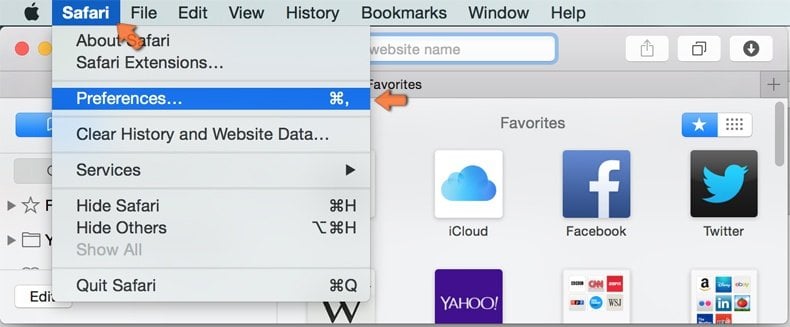
Make sure your Safari browser is active and click Safari menu, then select Preferences...
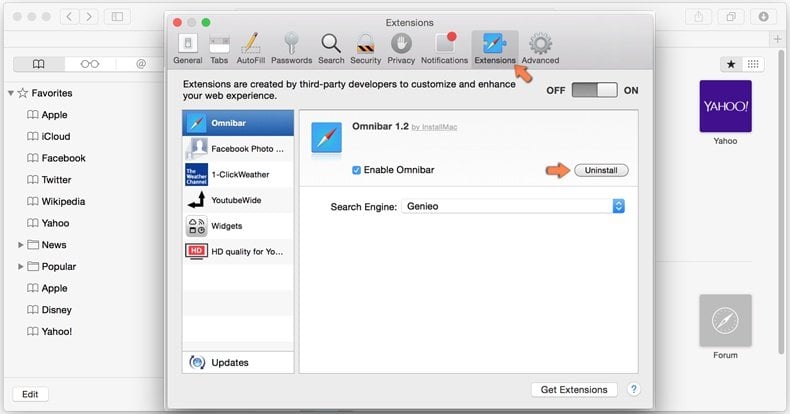
In the preferences window select the Extensions tab. Look for any recently installed suspicious extensions and uninstall them.
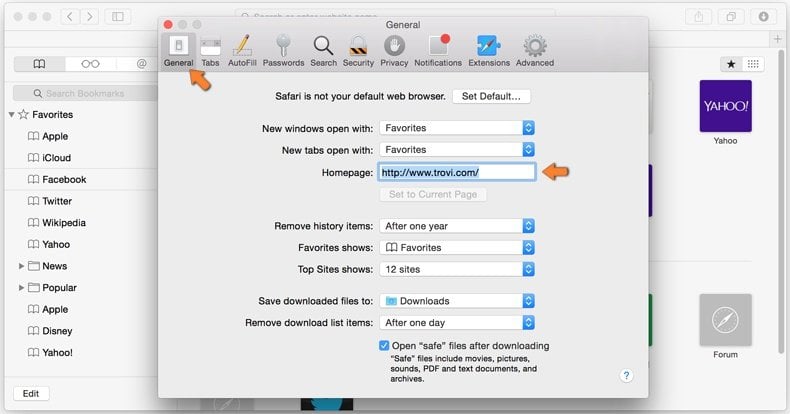
In the preferences window select General tab and make sure that your homepage is set to a preferred URL, if its altered by a browser hijacker - change it.
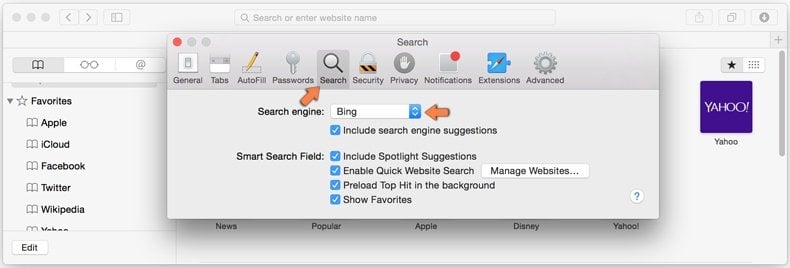
In the preferences window select Search tab and make sure that your preferred Internet search engine is selected.
Optional method:
Make sure your Safari browser is active and click on Safari menu. From the drop down menu select Clear History and Website Data...

In the opened window select all history and click the Clear History button.

 Remove malicious extensions from Microsoft Edge:
Remove malicious extensions from Microsoft Edge:
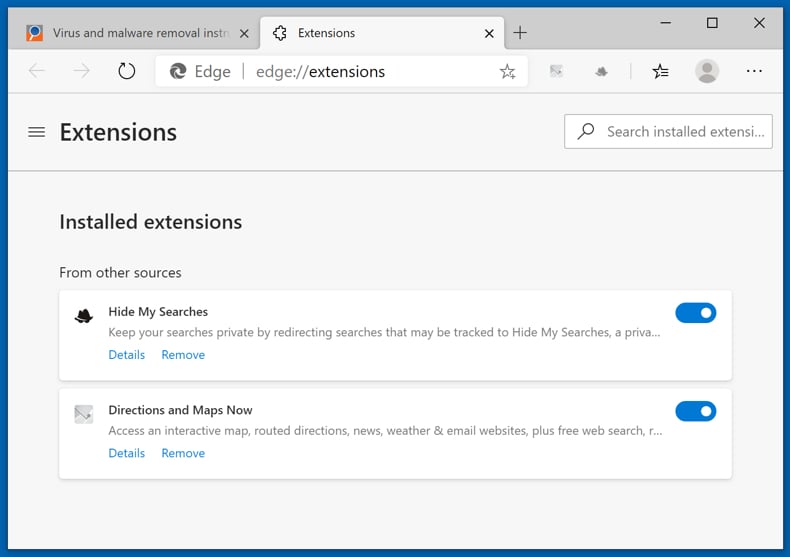
Click the Edge menu icon ![]() (at the top right corner of Microsoft Edge), select "Extensions". Locate any recently-installed suspicious browser add-ons, and remove them.
(at the top right corner of Microsoft Edge), select "Extensions". Locate any recently-installed suspicious browser add-ons, and remove them.
Change your homepage and new tab settings:
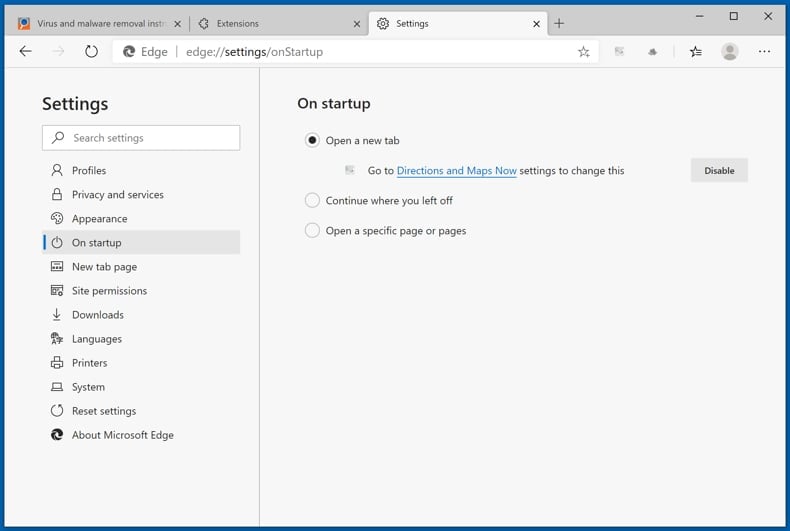
Click the Edge menu icon ![]() (at the top right corner of Microsoft Edge), select "Settings". In the "On startup" section look for the name of the browser hijacker and click "Disable".
(at the top right corner of Microsoft Edge), select "Settings". In the "On startup" section look for the name of the browser hijacker and click "Disable".
Change your default Internet search engine:
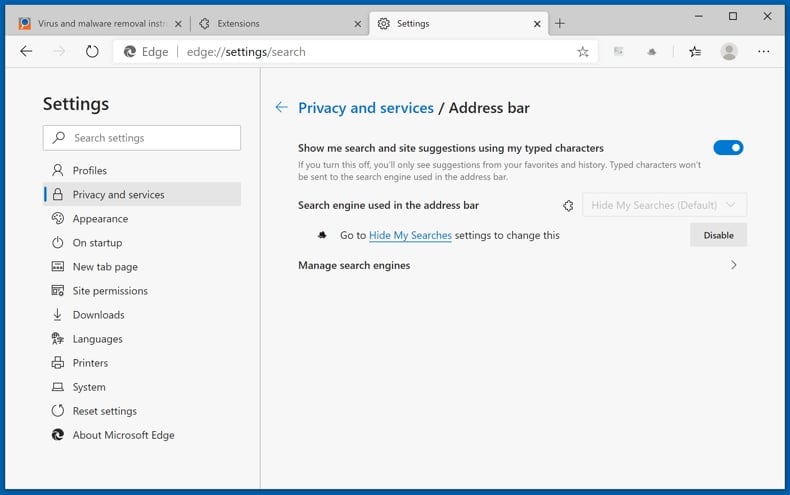
To change your default search engine in Microsoft Edge: Click the Edge menu icon ![]() (at the top right corner of Microsoft Edge), select "Privacy and services", scroll to bottom of the page and select "Address bar". In the "Search engines used in address bar" section look for the name of the unwanted Internet search engine, when located click the "Disable" button near it. Alternatively you can click on "Manage search engines", in the opened menu look for unwanted Internet search engine. Click on the puzzle icon
(at the top right corner of Microsoft Edge), select "Privacy and services", scroll to bottom of the page and select "Address bar". In the "Search engines used in address bar" section look for the name of the unwanted Internet search engine, when located click the "Disable" button near it. Alternatively you can click on "Manage search engines", in the opened menu look for unwanted Internet search engine. Click on the puzzle icon ![]() near it and select "Disable".
near it and select "Disable".
Optional method:
If you continue to have problems with removal of the qfind virus, reset your Microsoft Edge browser settings. Click the Edge menu icon ![]() (at the top right corner of Microsoft Edge) and select Settings.
(at the top right corner of Microsoft Edge) and select Settings.

In the opened settings menu select Reset settings.

Select Restore settings to their default values. In the opened window, confirm that you wish to reset Microsoft Edge settings to default by clicking the Reset button.

- If this did not help, follow these alternative instructions explaining how to reset the Microsoft Edge browser.
Summary:
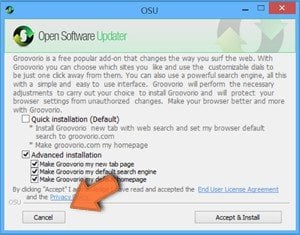 A browser hijacker is a type of adware infection that modifies Internet browser settings by assigning the homepage and default Internet search engine settings to some other (unwanted) website URL. Commonly, this type of adware infiltrates operating systems through free software downloads. If your download is managed by a download client, ensure that you decline offers to install advertised toolbars or applications that seek to change your homepage and default Internet search engine settings.
A browser hijacker is a type of adware infection that modifies Internet browser settings by assigning the homepage and default Internet search engine settings to some other (unwanted) website URL. Commonly, this type of adware infiltrates operating systems through free software downloads. If your download is managed by a download client, ensure that you decline offers to install advertised toolbars or applications that seek to change your homepage and default Internet search engine settings.
Post a comment:
If you have additional information on qfind virus or it's removal please share your knowledge in the comments section below.


▼ Show Discussion